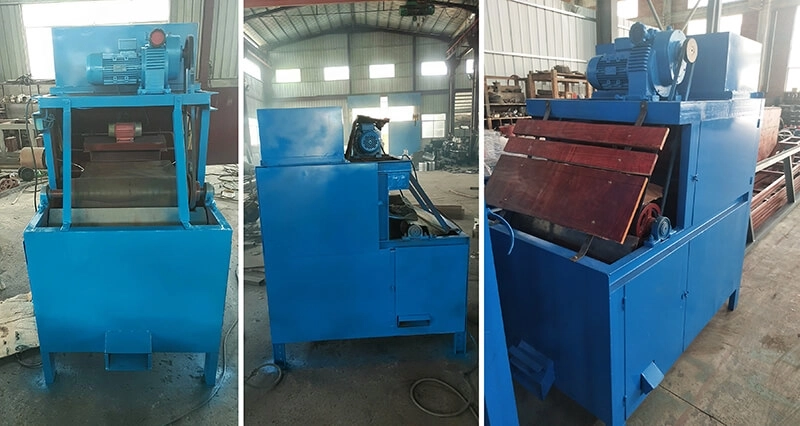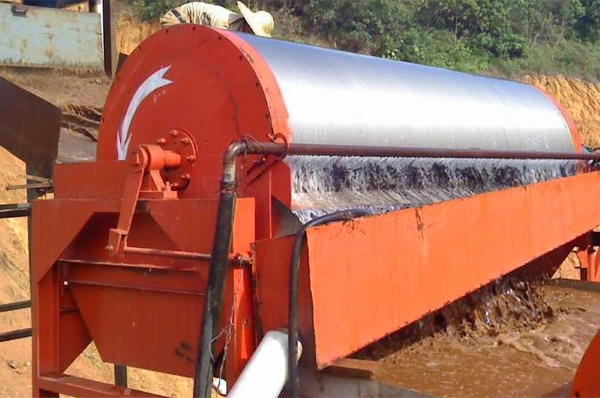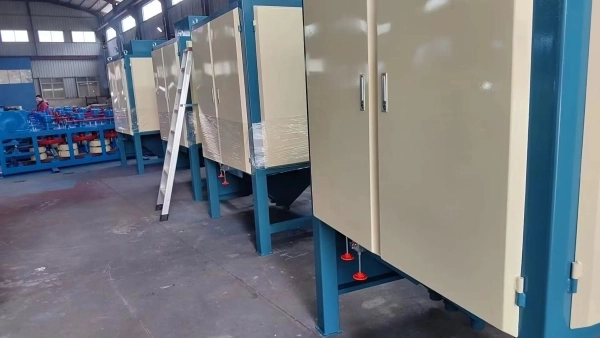Magnetic separators are essential tools in various industries, providing efficient material purification and separation capabilities. These devices utilize the power of magnetism to extract and separate magnetic particles from non-magnetic substances. While magnetic separators are robust and reliable, proper maintenance is crucial to ensure their optimal performance and longevity.

In this article, we will explore the importance of magnetic separator maintenance and discuss best practices for keeping these devices in excellent working condition. We will examine key maintenance tasks, common challenges, and effective strategies for troubleshooting and problem resolution. By implementing a proactive maintenance approach, industries can maximize the efficiency, productivity, and cost-effectiveness of their magnetic separation processes.
01 Importance of Magnetic Separator Maintenance
1. Enhancing Performance and Efficiency
Proper maintenance of magnetic separators ensures consistent and reliable performance. Regular inspection, cleaning, and lubrication contribute to the efficient operation of the device, leading to improved material separation, reduced downtime, and increased productivity.
2. Extending Equipment Lifespan
Well-maintained magnetic separators have a longer operational lifespan. By addressing potential issues promptly and implementing preventive measures, industries can avoid costly breakdowns, minimize repair expenses, and extend the overall lifespan of the equipment.
3. Ensuring Product Quality and Purity
Effective maintenance practices help maintain the integrity and purity of the separated materials. When magnetic separators are well-maintained, they can efficiently remove contaminants, ensuring that the final product meets quality standards and regulatory requirements.
4. Safety and Compliance
Regular maintenance of magnetic separators contributes to a safe working environment. By addressing potential safety hazards, such as loose components or damaged parts, industries can minimize the risk of accidents and ensure compliance with safety regulations.

(Dry Magnetic Separator)
02 Magnetic Separator Maintenance Best Practices
1. Regular Inspection and Cleaning
Conduct routine visual inspections of the magnetic separator to identify any signs of wear, damage, or misalignment. Inspect components such as magnetic drums, pulleys, belts, and housings. Clean the equipment regularly to remove accumulated debris, dust, or contaminants that may affect its performance.
2. Lubrication
Proper lubrication is essential for the smooth operation of moving parts in magnetic separators. Follow the manufacturer's recommendations for lubrication intervals and use high-quality lubricants that are compatible with the equipment's design and operating conditions. Ensure that lubricants are applied in the correct quantity and method to prevent over-lubrication or contamination.
3. Cleaning and Debris Removal
Regularly clean the magnetic separator to remove accumulated debris, such as ferrous contaminants or non-magnetic particles. Clean the surfaces of the magnetic components using appropriate cleaning techniques to ensure efficient magnetic separation. Remove any trapped material from the separator to prevent clogging or compromised performance.
4. Belt Maintenance
If the magnetic separator includes a conveyor belt, inspect and maintain the belt regularly. Check for signs of wear, tears, or misalignment. Adjust the tension and tracking of the belt as needed to ensure proper alignment and prevent material spillage. Clean the belt to remove any accumulated residue or particles.
5. Magnetic Strength Testing
Periodically measure and test the magnetic strength of the separator to ensure its effectiveness in capturing and separating magnetic particles. Use appropriate magnetic strength testing equipment and follow the manufacturer's guidelines for testing procedures. If the magnetic strength is found to be inadequate, consult the manufacturer for potential solutions or consider replacing the magnetic components.
6. Component Replacement
Over time, certain components of the magnetic separator may wear out or become damaged. Monitor the condition of critical parts such as magnetic drums, plates, and bars. Replace worn or damaged components promptly to maintain optimal performance. Follow the manufacturer's specifications and guidelines when replacing components to ensure compatibility and functionality.
7. Documentation and Maintenance Logs
Maintain detailed records of all maintenance activities, including inspections, cleaning, repairs, and component replacements. Create maintenance logs to track the frequency of maintenance tasks and note any issues encountered. This documentation helps establish a maintenance history, aids in troubleshooting, and supports future maintenance planning.
8. Safety Considerations
Prioritize safety during magnetic separator maintenance. Adhere to lockout/tagout procedures to de-energize and isolate the equipment before performing any maintenance tasks. Use appropriate personal protective equipment (PPE) as recommended by safety guidelines. Regularly review and reinforce safety protocols to minimize the risk of accidents or injuries.
9. Calibration and Performance Verification
Periodically calibrate and verify the performance of the magnetic separator to ensure its accuracy and efficiency. This may involve testing the magnetic field strength, evaluating the separation efficiency, or verifying the control settings. Follow the manufacturer's guidelines or consult experts for calibration procedures and recommended frequency.
10. Continuous Training and Industry Knowledge
Stay updated on the latest advancements, industry best practices, and emerging trends in magnetic separator maintenance. Attend training programs, workshops, or conferences to enhance your knowledge and skills. Engage with industry associations or online communities to exchange experiences and learn from others in the field.

(Magnetic Drum)
03 Troubleshooting and Problem Resolution
1. Problem Identification
When issues arise with the magnetic separator, employ systematic troubleshooting techniques to identify the root causes. Observe and analyze the symptoms, review maintenance records, and consult with experts if needed. Conduct thorough inspections, analyze data, and utilize tools such as vibration analysis or oil analysis to pinpoint the problem.
2. Root Cause Analysis
Perform a root cause analysis to determine the underlying reason for the issue. Use techniques like the 5 Whys method or fishbone diagrams to identify contributing factors and establish the primary cause. This analysis helps in developing effective solutions and preventing similar problems in the future.
3. Problem Resolution and Preventive Measures
Develop an action plan for resolving the identified problem based on the root cause analysis. Implement appropriate solutions, which may include component replacement, adjustments to operating parameters, or process improvements. Additionally, identify preventive measures to avoid similar issues in the future, such as modifying maintenance practices, updating procedures, or enhancing training programs.
4. Data Analysis and Trend Monitoring
Utilize data analysis techniques to identify patterns or trends related to magnetic separator performance. Monitor and track variables such as material feed rate, magnetic field strength, and separation efficiency. Analyzing this data over time can help identify potential issues and deviations from normal operating conditions, enabling proactive troubleshooting.
5. Collaboration with Operations Team
Foster collaboration between the maintenance and operations teams to gather valuable insights and observations. The operations team can provide information about any changes in the process, material characteristics, or operating parameters that could impact the magnetic separator's performance. This collaboration can aid in troubleshooting and identifying the root causes of problems.
6. Review of Maintenance Records
Thoroughly examine maintenance records and documentation to identify any recurring issues or patterns of failure. Look for commonalities in repairs, component replacements, or maintenance tasks performed. This analysis can help pinpoint underlying causes and guide effective problem resolution.
7. Consultation with Manufacturer or Experts
If troubleshooting efforts within your team do not yield satisfactory results, consider consulting the magnetic separator manufacturer or industry experts. They possess specialized knowledge and experience in the design, operation, and maintenance of magnetic separators. They can provide valuable insights, recommend troubleshooting strategies, or help identify uncommon or complex issues.
8. Root Cause Analysis Techniques
Apply root cause analysis techniques to systematically identify the underlying causes of problems. Techniques such as the 5 Whys method or fishbone diagrams can help trace the problem back to its root cause. By addressing the root cause rather than just the symptoms, you can implement more effective and lasting solutions.
9. Performance Testing and Validation
Perform performance tests to validate the effectiveness of the magnetic separator after implementing troubleshooting measures. These tests can involve running controlled experiments or using test materials with known magnetic properties. Evaluate the separation efficiency, magnetic field strength, and product quality to ensure that the problem has been resolved and the device is functioning optimally.
10. Continuous Improvement and Lessons Learned
Embrace a culture of continuous improvement by capturing and documenting lessons learned from troubleshooting experiences. Share these lessons across the maintenance team and incorporate them into future maintenance practices. This iterative approach ensures that knowledge is retained and applied to enhance troubleshooting efficiency and problem resolution in the future.
Remember, effective troubleshooting requires a systematic approach, collaboration, and a keen understanding of the magnetic separator's design and operation. By employing these strategies and techniques, you can identify and resolve issues promptly, minimizing downtime and maximizing the performance of your magnetic separators.

04Conclusion
In conclusion, effective maintenance practices are crucial for ensuring the optimal performance and longevity of magnetic separators. By adhering to best practices, industries can minimize downtime, improve product quality, and enhance overall operational efficiency. Regular inspections, proper lubrication, and thorough cleaning are essential maintenance tasks to prevent wear, misalignment, and clogging. Additionally, training maintenance personnel, maintaining comprehensive documentation, and prioritizing safety create a solid foundation for successful maintenance programs. Collaborating with manufacturers and experts, conducting root cause analyses, and utilizing condition monitoring techniques aid in efficient troubleshooting and problem resolution. Continuous improvement, data analysis, and performance validation contribute to ongoing maintenance optimization.
By implementing these best practices, industries can maximize the potential of their magnetic separators and ensure reliable and efficient separation of ferrous contaminants, ultimately benefiting their processes and products.
- Random article
- Popular articles
- Popular comments
- Iron ore reverse flotation process
- Arsenic Gold Ore Wet Chemical Pretreatment Process
- Floatability flotation process for lead-zinc ore
- Laterite Nickel Ore: Pyrometallurgical Treatment
- Zirconium Ore Processing: Gravity, Magnetic, and Electric Separation
- chrome ore processing:Advanced Magnetic Separation Processing Technology
- Chromite Gravity, Magnetic, and Electric Separation Process








Leave a message with your needs or comments
Add comment: